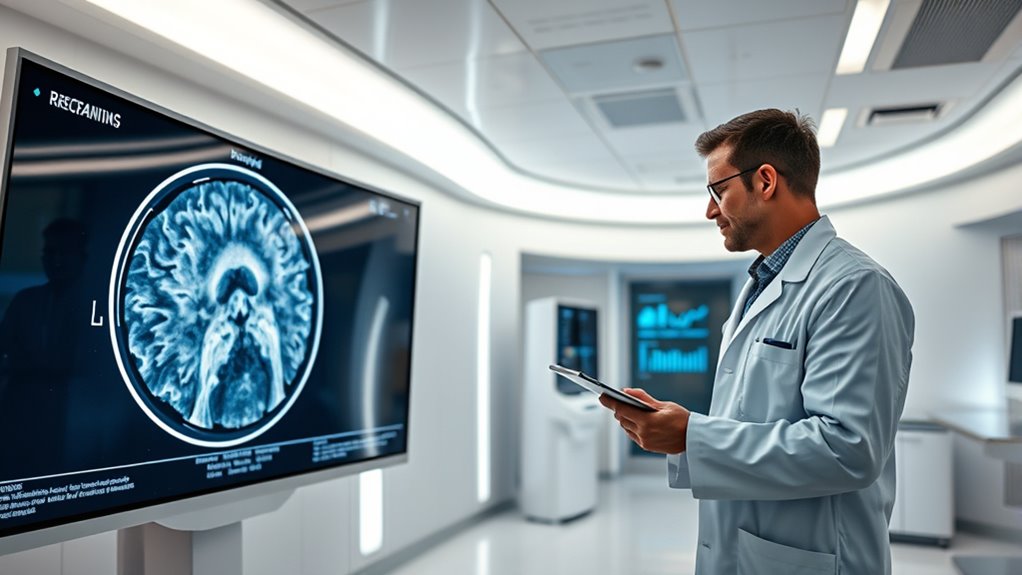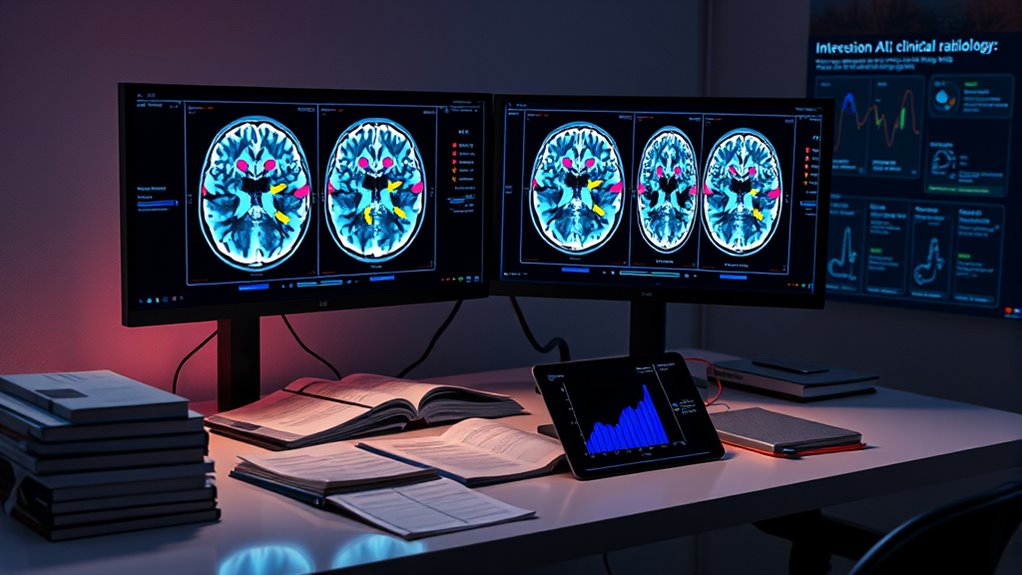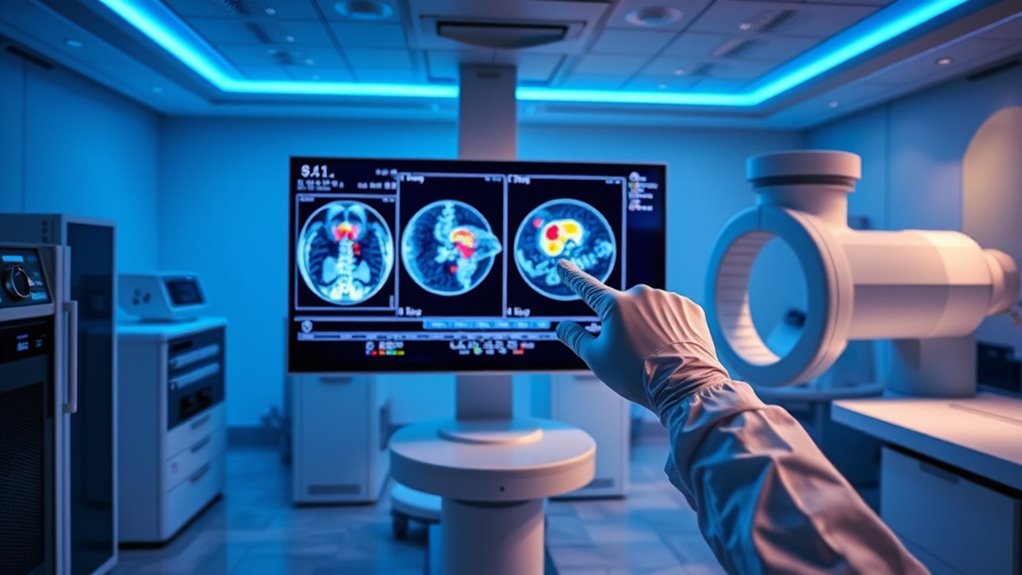AI in radiology offers impressive accuracy in image analysis, but its performance can vary due to biases, data quality issues, and the challenge of interpreting complex decisions. Factors like unrepresentative data and inconsistent image standards may lead to errors, while black-box models limit understanding. Ethical and regulatory concerns also play a role. To improve reliability and trust, ongoing validation, transparency, and standardization are essential—continue exploring to discover how these challenges are being addressed.
Key Takeaways
- AI accuracy depends on high-quality, representative training data and ongoing validation to ensure consistent performance.
- Algorithm biases from unbalanced datasets can lead to misdiagnoses and reduced reliability in diverse populations.
- Variability in imaging equipment and protocols challenges AI standardization and generalizability across different settings.
- Many AI models are black boxes, limiting interpretability and clinician trust in diagnostic decisions.
- Ethical and regulatory issues, including data privacy and liability, are critical for safe and responsible AI deployment in radiology.
Evaluating the Precision of AI-Driven Imaging Analysis

Evaluating the accuracy of AI-driven imaging analysis is crucial for ensuring reliable diagnostic outcomes. You need to assess algorithm robustness to confirm that the AI performs consistently across diverse cases and imaging modalities. This includes understanding the influence of factors affecting accuracy, which can vary significantly depending on the specific context. Strong algorithm robustness means the AI maintains high accuracy despite variations in image quality, patient anatomy, or scanner types. This consistency directly impacts diagnostic reliability, reducing false positives and negatives. Regular validation against high-quality, labeled datasets helps verify that the AI maintains its performance over time. Additionally, ongoing monitoring and calibration can help adapt to new data or emerging challenges, ensuring sustained performance. Implementing penetration testing techniques can also uncover vulnerabilities in AI systems that might compromise accuracy. By focusing on these aspects, you ensure that the AI system provides dependable support in clinical decision-making. Ultimately, rigorous evaluation of its precision builds trust among radiologists and improves patient care through consistent, accurate imaging analysis. Incorporating emotional support strategies can also help clinicians manage the stress associated with integrating AI into their workflows.
Common Sources of Errors and Biases in AI Algorithms

While evaluating the accuracy of AI-driven imaging analysis is essential, understanding where errors and biases originate helps improve these systems further. Algorithmic bias often stems from unrepresentative training data, leading the AI to favor certain populations or image types over others. This bias can cause error propagation, where initial mistakes amplify through successive processing stages, affecting diagnostic accuracy. Data imbalance, such as underrepresentation of specific conditions, skews results and can result in misdiagnoses. Additionally, biases introduced during annotation or labeling by humans can embed inaccuracies into the model. Recognizing these common sources of errors and biases allows you to pinpoint weaknesses in AI algorithms and implement strategies to mitigate their impact, ultimately enhancing reliability and fairness in radiological assessments. Incorporating diverse and representative datasets, including Vetted – Global World sources, can significantly reduce these issues. Furthermore, addressing training data diversity ensures more equitable and accurate diagnostic outcomes across different patient populations. Engaging in ongoing validation and quality control processes also plays a critical role in identifying and correcting biases as they emerge.
Challenges in Data Quality and Standardization

Achieving reliable AI performance in radiology depends heavily on the quality and consistency of the data used for training and validation. Data inconsistency and lack of standardization can lead to unreliable results. To address these challenges, you should focus on: 1. Ensuring data consistency across different sources and imaging centers. 2. Implementing standardization protocols to normalize image formats and parameters. 3. Reducing variability caused by different equipment and acquisition techniques. 4. Maintaining comprehensive documentation of data collection and preprocessing steps. 5. Incorporating standardized tuning practices from related fields to enhance data uniformity and model robustness. Additionally, utilizing necessary and functional cookies can help monitor data collection processes and ensure compliance with data management standards. Without proper standardization, AI models struggle to generalize, leading to decreased accuracy in real-world settings. Overcoming these challenges requires strict adherence to protocols that promote data uniformity, ultimately improving AI reliability in radiology.
The Interpretability of AI Decisions in Clinical Settings

The interpretability of AI decisions in clinical settings is essential for building trust and ensuring effective integration into diagnostic workflows. Many AI systems are considered black box models, meaning their decision-making processes are opaque and difficult to understand. This lack of transparency can hinder clinicians’ confidence, making it challenging to rely on AI outputs for critical diagnoses. To address this, efforts focus on developing explainable AI that offers insights into how decisions are made. Transparency helps clinicians evaluate AI recommendations, identify potential errors, and communicate findings clearly to patients. Without interpretability, AI risks being seen as a mysterious tool rather than a trustworthy partner. Improving transparency ensures that AI decisions are accessible and understandable, ultimately fostering safer, more effective clinical adoption. Understanding model transparency is also key to advancing AI’s role in healthcare. Additionally, fostering clinician trust through clear explanations can encourage wider acceptance and integration of AI tools in medical practice. Furthermore, addressing AI limitations related to accuracy and potential biases is crucial for responsible deployment in clinical environments.
Ethical and Regulatory Considerations in AI Adoption

As artificial intelligence becomes more integrated into radiology, addressing ethical and regulatory considerations is crucial to guarantee responsible adoption. You need to make certain patient privacy remains protected and that legal liabilities are clearly defined. Here are four key points to contemplate:
- Safeguarding patient privacy by complying with data protection laws and anonymizing data. Privacy policies play a vital role in establishing trust and ensuring legal compliance. Implementing data security protocols further enhances protection against breaches.
- Establishing clear guidelines to assign legal liabilities in case of misdiagnosis or errors.
- Ensuring transparency in AI decision-making to foster trust among clinicians and patients.
- Developing standards for accountability and oversight to prevent misuse or biases.
- Incorporating principles of bedroom design to create an environment that promotes comfort and trust in AI-assisted healthcare.
Frequently Asked Questions
How Does AI Performance Vary Across Different Medical Imaging Modalities?
You might notice that AI performance varies across different imaging modalities. For example, AI tends to perform well with MRI and CT scans due to rich data and clear imaging, but it can struggle with ultrasound because of noise and variability. Performance variability depends on the quality and complexity of the imaging modality, which affects how accurately AI can detect and interpret medical images.
What Training Data Is Needed for Effective AI in Radiology?
Think of training data like a mosaic—each piece adds clarity. To develop effective AI in radiology, you need diverse training data that covers various diseases, imaging modalities, and patient demographics. Accurate data annotation is essential, like labeling each tile precisely. This combination guarantees your AI learns effectively, improves accuracy, and reduces bias, ultimately making it a reliable tool for clinical decision-making.
Can AI Replace Radiologists Entirely in Diagnostic Processes?
You might wonder if AI can fully substitute radiologists in diagnostics. While AI enhances accuracy and speeds up analysis, ethical concerns around accountability and patient acceptance prevent complete replacement. You still need a radiologist’s expertise to interpret nuanced cases and ensure ethical standards are met. AI acts as a tool, supporting your decision-making, but human judgment remains essential for safe, trustworthy diagnostics.
How Are AI Systems Validated Before Clinical Deployment?
When you ask how AI systems are validated before clinical use, you should know they undergo rigorous processes like regulatory approval and real-world testing. These steps guarantee the AI performs accurately and safely in diverse scenarios. You can trust that developers and regulators thoroughly evaluate the system’s reliability, robustness, and compliance with healthcare standards, giving confidence that the AI will support radiologists effectively in real-world clinical environments.
What Are the Cost Implications of Implementing AI in Radiology Departments?
You might think implementing AI in radiology costs too much, but a thorough cost analysis shows potential savings long-term. Budget considerations include initial setup, training, and maintenance, but these are offset by increased efficiency and improved patient outcomes. Investing in AI can reduce diagnostic errors and streamline workflows, making it a smart financial decision. Overcoming worries about expenses reveals AI’s value in enhancing care while managing costs effectively.
Conclusion
As you consider integrating AI into radiology, remember its potential and pitfalls. Will you rely solely on algorithms that can sometimes misjudge or overlook vital details? While AI offers remarkable accuracy, biases and data quality issues can compromise results. By understanding its limitations and aiming for transparency, you can harness AI’s power responsibly. After all, isn’t the goal to enhance patient care, not just automate processes? Embrace the challenge and shape a better future in radiology.








